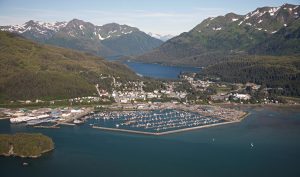NOAA’s 2024 Seafood Industry Report
 Alaska’s seafood industry, a cornerstone of the state’s economy and U.S. fisheries, is facing significant hurdles, as revealed in NOAA’s 2024 report. Economic conditions, workforce challenges, and climate impacts are driving this once-thriving sector into a difficult period, resulting in substantial declines in profits and industry-wide layoffs.
Alaska’s seafood industry, a cornerstone of the state’s economy and U.S. fisheries, is facing significant hurdles, as revealed in NOAA’s 2024 report. Economic conditions, workforce challenges, and climate impacts are driving this once-thriving sector into a difficult period, resulting in substantial declines in profits and industry-wide layoffs.
Economic Downturn and Job Losses
The report details that from 2021 to 2023, Alaska’s seafood industry saw a 50% drop in profitability, largely due to rising costs for fuel, labor, and materials combined with declining global seafood prices. In total, the industry suffered a revenue loss of around $1.8 billion, impacting over 38,000 jobs across the United States, including workers in Alaska and beyond. This economic slump is attributed to global market competition and a complex web of supply chain issues that continue to hinder recovery efforts.
These economic losses are especially hard-hitting for Alaska’s remote coastal communities, many of which rely heavily on fishing for employment, community stability, and tax revenue. With revenue down, these towns and villages face growing uncertainties regarding public funding and basic services.
Climate Change as a Pressing Threat
The report also underscores the increasing effects of climate change on Alaska’s marine ecosystems. Rising sea temperatures and shifting ocean currents are impacting species distributions and affecting fish stocks vital to the Alaskan seafood market, particularly for key species like salmon, crab, and pollock. The changing conditions are resulting in smaller fish harvests and lower yields, contributing further to the industry’s economic challenges.
Warmer waters are also exacerbating the spread of marine diseases and harmful algal blooms, posing further risks to fish populations and making regulatory management of fisheries even more complex. The NOAA report warns that if these trends continue, they could drive significant changes in Alaska’s marine ecosystems, disrupting the balance needed for sustainable fishing practices.
Regulatory Changes and Adaptations
As the industry contends with both economic and environmental challenges, NOAA’s report notes that Alaska’s seafood producers are being driven to adopt more sustainable and resilient practices. Some efforts include investing in sustainable fishing techniques and adjusting harvest quotas to maintain fish populations. Additionally, regulatory bodies are reevaluating management strategies to account for the changing ecosystem, ensuring the sustainability of the fisheries and the communities they support.
However, adapting to these new practices often brings additional costs and logistical challenges. Fishermen and seafood processors are now forced to weigh short-term economic pressures against long-term sustainability, further complicating an already difficult operational landscape.
Looking Forward: Support and Innovation Needed
NOAA’s 2024 snapshot concludes with a call for enhanced support for Alaska’s seafood industry, emphasizing that government intervention, innovative technology, and increased resilience efforts are essential to the industry’s recovery and growth. By expanding research into climate adaptation strategies, providing financial support to coastal communities, and strengthening global competitiveness, Alaska’s seafood industry might stabilize in the coming years.
Overall, the 2024 NOAA report paints a clear picture of an industry at a crossroads. Facing unprecedented economic, environmental, and regulatory challenges, Alaska’s seafood sector must adapt quickly to survive. The path forward will require balancing ecological sustainability with economic viability, a challenge that will define the future of one of America’s most important and iconic industries.
For full insights, the report can be viewed at Alaska Seafood Snapshot.
 Maritime Injury Law Blog
Maritime Injury Law Blog

